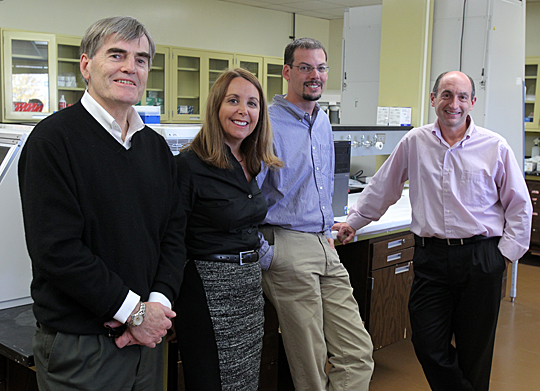Call it the Ebola of the gill-bearing world: the Viral Hemorrhagic Septicemia virus (VHSv) causes deadly bleeding in more than 80 marine and freshwater fish species across the Northern Hemisphere. Though VHSv poses no known danger to humans, it’s been implicated in fish die-offs from the Baltic Sea to the Pacific Ocean and — worryingly for the regional economies dependent on a healthy ecosystem — the Great Lakes.

UT researchers are investigating the Viral Hemorrhagic Septicemia virus that causes deadly bleeding in more than 80 marine and freshwater fish species. They are, from left, Dr. Jim Willey, Dr. Carol Stepien, Dr. Jonathan Bossenbroek and Dr. Douglas Leaman.
Funded by the U.S. Department of Agriculture, the National Science Foundation and an Ohio Sea Grant through the National Oceanic and Atmospheric Administration, the project was initiated and continues to be coordinated by Dr. Carol Stepien, professor of ecology and director of the University’s Lake Erie Center.
In fact, it literally washed up on the shore, Stepien said: “In the water directly across from the center, we observed many fish that had died of hemorrhages. It turned out to be part of the first outbreak of VHSv in [Lake Erie] waters.”
Stepien from the beginning had a particular interest in the capability of some viruses, including VHSv, to evolve very quickly.
Serendipitously, it was around this time that she met Dr. Jim Willey, UT professor of medicine and pathology, and George Isaac Professor for Cancer Research. His lab’s expertise in developing molecular diagnostic tests would be central to the project.
Early on, Stepien and Willey identified the importance of developing a rapid genetic test that could be used on the virus, since traditional cell culturing can take more than a month.
“Our lab’s usual focus is on lung cancer in humans, but we were able to use a similar approach to develop a good test for VHSv,” Willey said. “A key property of our test is that it includes quality control, which reduces the number of false negatives and false positives, and allows the results to be more easily reproduced from one lab to another.”
To maintain precise standardizations for the test, well-defined samples of fish cells are necessary. Enter Dr. Douglas Leaman, professor and chair of the UT Department of Biological Sciences, whose group was able to culture fish cells and grow VHSv in the laboratory.
As an immunologist, Leaman was surprised by how little research existed regarding how the fish hosts’ bodies respond to the virus: “VHSv is closely related to a mammalian virus I already work on, and we knew that fish and mammals shared components of their innate immune systems that play a major role in fighting the virus.”
His work on livestock interferons, a family of antiviral proteins activated upon infection in mammals, made him wonder if interferon activation by VHSv was similar in fish. If so, would the virus fight back and overcome the defenses?
By dissecting the virus, Leaman’s group identified at least two viral proteins that appear to block the actions of the fish innate immune response. They then focused on the mechanisms used by the viral proteins to disable interferon responses and allow viral dissemination. Ultimately, the researchers hope to discover whether all strains of VHSv defend themselves this way or if some strains are better at it.
Leaman asked, “When the virus moves into a new ecosystem like the Great Lakes, is that event associated with an increase in the virus’ ability to overcome the host’s defenses?”
The next step is a series of studies on fish deliberately infected with known strains of VHSv. That research will take place at a contained U.S. Geological Survey facility in West Virginia.
Where will the virus move next in the waters of the Great Lakes? Dr. Jonathan Bossenbroek , associate professor of ecology in the UT Department of Environmental Sciences, is working to crack the patterns by which VHSv “migrates.”
“The virus was first detected in Lake St. Clair, then Lake Erie, then several years later near Duluth, Minnesota,” he noted. “One of the obvious explanations is shipping, the movement of ballast water. One of my graduate students, Jenn Sieracki, is developing a model that we hope will quantify the pattern of the virus’ movement in relation to shipping routes.”
Given its implications for global fish stocks, the project is generating new applications. Bossenbroek’s group is using VHSv as its first model to predict the movement of any aquatic invasive species. The rapid genetic test developed by Willey’s lab is being converted to a platform that can be used by analysis labs nationwide. A paper Stepien co-authored with graduate student Lindsey Pierce used DNA analysis to track emerging variants of the virus; in September, they presented it at a conference in Marseille, France.
Scientific collaborators include the University of Michigan, Notre Dame University, Cornell University, the University of Wisconsin-Milwaukee and the U.S. Geological Survey in Seattle.
VHSv is here to stay, Stepien noted, though its presence may be morphing almost daily: “Today, many fish in Lake Erie will test positive for the virus but not display symptoms. So it’s become endemic, as though the fish have developed antibodies or the virus is not as virulent as before.
“It’s an evolutionary arms race between the virus and the fish: Who adapts to changes in the other?”